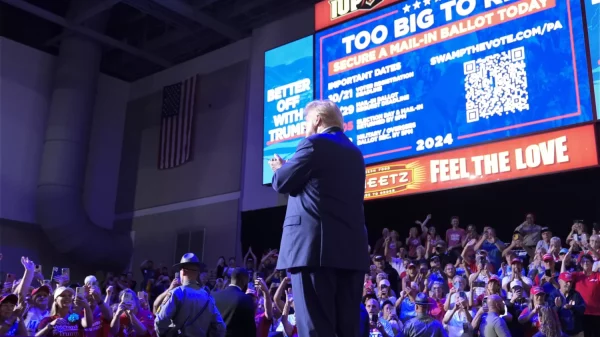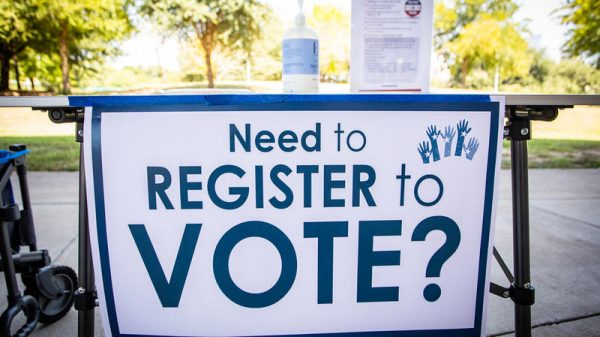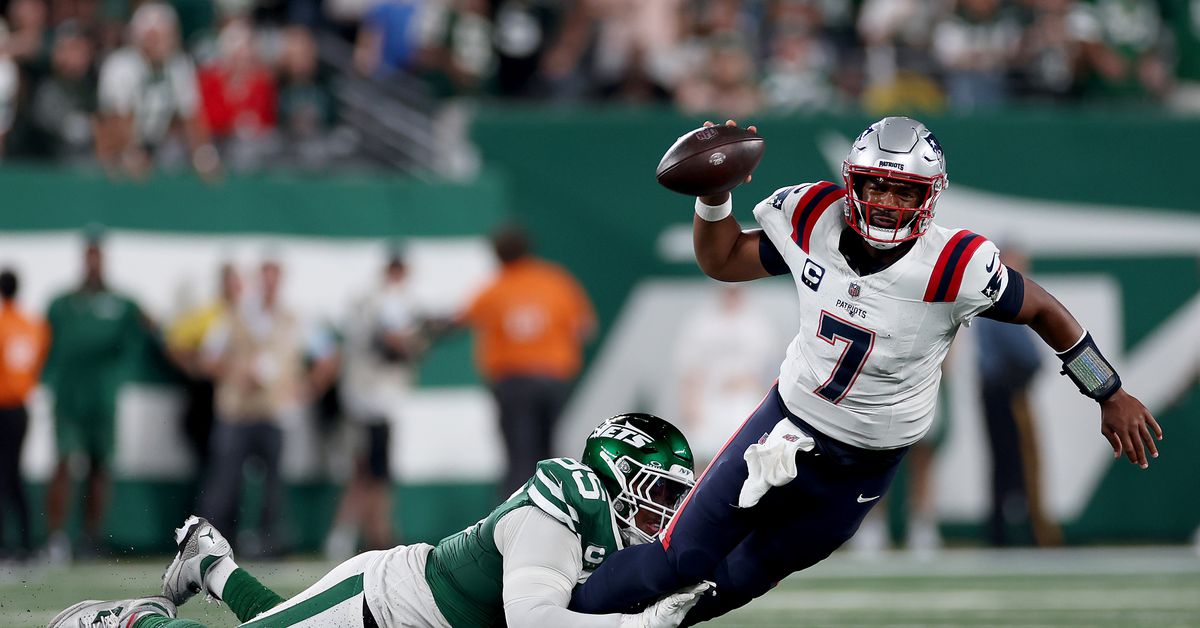In recent memory, there aren’t many examples of the San Francisco 49ers playing with a losing record under Kyle Shanahan. The good news is that the Niners have won — and covered the spread — their last five games when playing with a losing record.
Let’s understand why that number will turn six this Sunday, starting with when the New England Patriots have the ball.
Ground and pound…kinda
Defensive coordinator Nick Sorensen was asked what stands out about the Patriots offense. The first words to come out of his mouth were, “Well, they can really run the ball.”
The Patriots’ offensive identity is running the ball again and again. New England runs the ball because they have to, but they’re not particularly good at it. The Pats run the ball at the eighth-highest rate yet sit 18th in rushing success rate—a stat that measures down-to-down efficiency. They’re slightly better in rushing EPA—a stat we can use to measure big-play ability—at 13th. Neither of those marks is anything to write home about.
Getting stops on the ground has not been the 49ers defense’s forte through three games. They rank 25th in rushing success rate and 28th in rushing EPA allowed.
The 49ers are thin at defensive tackle with the loss of Javon Hargrave and Jordan Elliott’s addition to the injury report on Thursday. Still, what they have going for them is New England’s lack of push. The Patriots are 30th in the NFL in yards before contact at 0.55. The New York Jets, who we can use as a measuring stick from Week 1, are ranked one spot below the Pats.
It’ll be interesting to see if Sorensen overcompensates for the loss of Hargrave and puts more defenders in the box. That has not been his M.O. so far, as the 49ers have only used a stacked box 18 percent of the time.
Something must change. Well, something’s gotta give because San Francisco is near the top of the league in yards before contact allowed, at 1.69. It’ll be a battle between the moveable object and the immovable force.
The defense will be tasked with stopping a pair of near-230 pound-ish running backs in Rhamondre Stevenson and Antonio Gibson. They are the bigger, bruising type, but they won’t make you miss and aren’t overly elusive. The Jets erased the Patriots’ running game the same way you’d expect the 49ers to: Scoring early and making New England one-dimensional.
One area where the 49ers have excelled is tackling. During the previous two games, they’ve only missed five tackles. Two came from Talanoa Hufanga—at the goal line when Kyren Williams flipped over him—and Malik Mustapha last week. Against the Vikings, it was the two defensive tackles. If they wrap up the Patriots running backs on early downs, they should be able to get off the field. Should, being used loosely, of course.
Anemic through the air
The 49ers return home to their friendly confines, where they’ve been installed as a 10.5-point favorite against the New England Patriots. These are two offenses that are on the opposite ends of the spectrum when it comes to throwing the ball:
Yards on 10+ yard throws:
Most: 49ers 581
Fewest: Patriots 84— Steve Palazzolo (@StevePalazzolo_) September 26, 2024
Brock Purdy is second in the NFL in average throw depth at 9.4 yards. Jacoby Brissett is 17th, averaging 6.5.
Charvarius Ward is not on the injury report. After being hampered by a hamstring in Week 3, it feels like Mooney has allowed more deep routes in the previous two games than he did in the second half of last season. Kyle Shanahan acknowledged that Ward was caught sleeping on one of the deep passes last week.
Sorensen said the 49ers defense has been inconsistent on third downs this year: “Like I said, it’s not one thing. It’s been tough. It is frustrating at times because sometimes it’s really good.”
The “really good” has been few and far between. The 49ers are 28th in EPA per play and success rate on third and fourth downs. Not only are they struggling to get off the field, but when they don’t, it usually results in an explosive play for the offense.
Circling back to the Patriots and Brissett, specifically, and where he’s thrown the ball. Brissett doesn’t seem too keen on throwing the ball down the field. He has five attempts over 20 yards this season and only nine attempts beyond 10 yards.
Purdy has as many completions over 20 yards as Brissett has attempted. Brock’s completed nearly twice as many passes between the numbers at the intermediate level as Brissett has attempted. These offenses are not playing the same sport.
New England’s passing attack consists of two players: Tight end Hunter Henry and wide receiver Demario Douglas. Those are the only players with double-digit targets on the season. Austin Hooper, the only other pass catcher with north of 50 receiving yards, has nine targets.
When your plan of attack is to drop back and throw it over the middle against the Niners, you generally end up punting. That’s where Fred Warner roams. Now, Sean McVay knows how to manipulate defenses. He put three eligibles to one side, knowing Warner was responsible for whomever No. 3 was, and isolated De’Vondre Campbell 1-on-1 on the backside.
The results were good if you were on offense. Campbell gave up a touchdown and committed a critical pass interference. The 49ers are using a linebacker who came off the field last year in Green Bay on passing downs. So, can we blame Campbell for not being adept in coverage?
If only there were a young, speedy linebacker on the roster who was drafted for this reason:
Dee Winters only played about seven snaps for the 49ers in Week 3. But check out his activity and energy in these four snaps. He’s always looking for work.
Even from training camp, I got Kwon from ’19 vibes. His effort level is infectious and the type you can feed off pic.twitter.com/X6TMfBN1iV
— Kyle Posey (@KP_Show) September 26, 2024
In the first clip above, Winters undercuts the quick out route from the tight end. In the other clips, Winters is constantly on the move, looking to get involved in the play.
If you’re worried about Winters holding up on running downs, New England runs inside of the tackles on only 40 percent of its carries. They’re playing into the hands of Winters.
Dee needs to stay healthy. That’s his most significant hurdle to overcome.
Scoring has been a struggle for New England. Their outputs have been 16, 20, and 3 in three games. Even in the 20-point outburst against Seattle in Week 2, Brissett only threw for 149 yards — 109 of them to Henry. And those numbers are inflated, as 35 came on a screen.
Pressuring Brissett
Jacoby deserves his flowers for his mobility in the pocket and ability to evade and extend plays. These have been the driving forces of the Patriots’ passing game to date.
The good news for the Niners is that Brissett has plenty of practice. The Patriots have allowed the second-highest pressure rate in the NFL despite being blitzed at a league-average rate.
This is where the loss of Hargrave will come into play. Nick Bosa will get his in the same way Trey Hendrickson (seven pressures), Boye Mafe (seven pressures), and Will McDonald (six pressures) did. It would go against the grain if Bosa weren’t disruptive. But this is where Lenoard Floyd needs to earn his paycheck.
The Seahawks had two other pass rushers with at least four pressures, while the Jets and Bengals each had multiple players with three. The process of elimination says it’s on Floyd to be Bosa’s Robin.
Brissett shook free on multiple occasions in Week 1, where he scrambled for 34 yards. He has since quieted down, but the Niners have historically struggled with quarterbacks who are a threat to run. At this stage in his career, that’s not Brissett, who still moves well but looks to throw first and second before taking off.
Why does Brissett take off, you ask? In this space, Colton McKivitz is recognized as a player who is hardly starting material for an offensive lineman. What if I told you the Patriots left tackle has a higher blown block percentage than McKivitz? Unfortunately, Vederian Lowe did not play in Week 3 and has not practiced this week. Lowe and Caedan Wallace, who started last week against New York, were both sporting braces on their knees during practice this week.
Wallace has been slightly worse than McKivitz in pass protection, with a whopping 7.7 blown block percentage against the pass. If he’s not healthy, that leaves Demontrey Jacobs, who would be the third left tackle in four games for the Patriots. Jacobs is an undrafted free agent from the class of 2023. Jacobs allowed one sack on 11 pass-blocking snaps.
It was a meaningless sack at the end of the game, but this does not look like the caliber of player Bosa, Floyd, or Yetur Gross-Matos should struggle against:
Drake Maye is sacked to end the game. Looked like he might have had Douglas open over the top but didn’t have enough time to stand in the pocket and deliver it to him pic.twitter.com/DtmWoTVSTV
— Ben Brown (@BenBrownPL) September 20, 2024
For as many issues as the 49ers have had stopping the run, explosive passing plays, or getting off the field on third downs, the Patriots offense trumps them. New England does not possess the firepower the Vikings or Rams do at quarterback or receiver. Schematically, they don’t present the same challenges.
If there was ever a “get-right” spot early in the season for this 49ers defense, it’s the Patriots offense.




![Tyson Foods Plant [Photo: Food Manufacturing]](https://southarkansassun.com/wp-content/uploads/2023/08/iStock_1185520857__1_.5e441daa51cca-600x337.jpg)








![Silverado Senior Living Management Inc. [Photo: Los Angeles Times]](https://southarkansassun.com/wp-content/uploads/2023/10/download-6-4-600x337.jpg)

![China's Wuhan Institute of Virology [Photo: Nature]](https://southarkansassun.com/wp-content/uploads/2023/09/d41586-021-01529-3_19239608-600x337.jpg)















